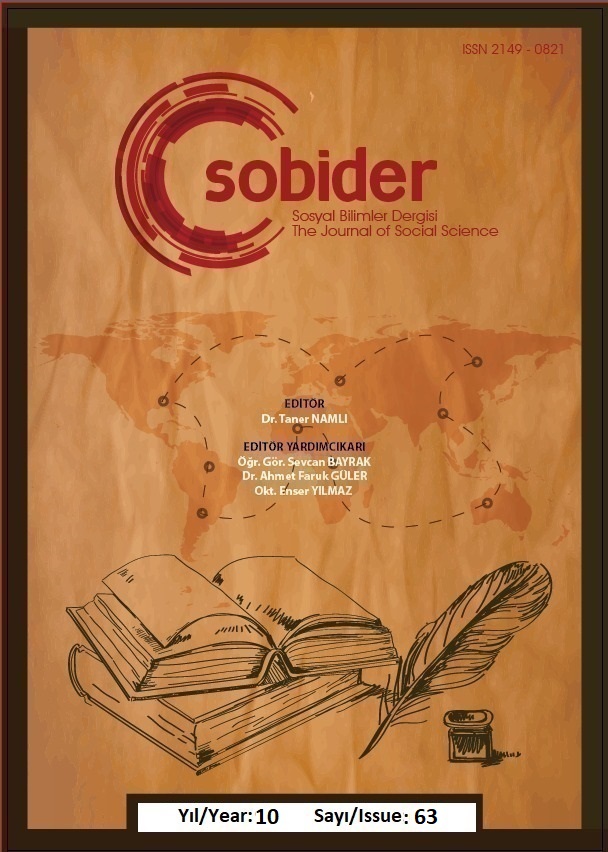Author :
Abstract
Amaç: Bu çalışmada ortaokul ve lise düzeyinde öğrenim gören öğrencilerin fiziksel aktiviteye katılım düzeylerinin incelenmesi amaçlanmıştır.
Yöntem: Araştırma grubunu Bitlis ilinde lisede (125 kişi) ve ortaokulda (125 kişi) öğrenim gören 250 (162 erkek, kadın 88) gönüllü öğrenci oluşturmuştur. Araştırma da veri toplama aracı olarak, “Kişisel Bilgi Formu”, ile öğrencilerin fiziksel aktiviteye katılımlarını belirlemeye yönelik “Fiziksel Aktiviteye Katılım Motivasyonu Ölçeği (FAKMÖ)” kullanılmıştır.
Bulgular: Araştırma grubunun, cinsiyet, boy ve algılanan ekonomik durum ile ölçek toplam puan ve ölçek alt boyutları puan ortalaması arasında istatistiksel olarak anlamlı farklılık olmadığı belirlenmiştir (p>0.05). Katılımcıların okul türü değişkeni ile ölçek toplam puan, çevresel nedenler ve nedensizlik alt boyutları puan ortalaması arasında istatistiksel olarak anlamlı farklılık olduğu belirlenirken (p<0,05), bireysel nedenler alt boyut puan ortalaması arasında anlamlı farklılık olmadığı belirlenmiştir (p>0.05). Araştırma grubunun egzersiz durumu ile ölçek toplam puan ve bireysel nedenler alt boyut puan ortalaması arasında istatistiksel olarak anlamlı farklılık olduğu belirlenirken (p<0,05), çevresel nedenler ve nedensizlik alt boyutları puan ortalaması arasında anlamlı farklılık olmadığı tespit edilmiştir (p>0.05). Katılımcıların vücut ağırlığı değişkeni ile nedensizlik ölçek alt boyut puan ortalaması arasında istatistiksel olarak anlamlı farklılık olduğu belirlenirken (p<0,05), ölçek toplam puan ve bireysel ve çevresel nedenler alt boyutları puan ortalaması arasında anlamlı farklılık olmadığı belirlenmiştir (p>0.05).
Sonuç: Araştırma grubunun fiziksel aktiviteye katılım düzeylerinin yüksek olduğu ve erkek öğrencilerin kız öğrencilere göre fiziksel aktiviteye katılım puan ortalamasının daha yüksek olduğu görülmüştür.
Keywords
Abstract
Aim: In this study, it was aimed to examine the physical activity participation levels of secondary and high school students.
Method: The research group consisted of 250 (162 male, 88 female) volunteer students studying at high school (125 people) and secondary school (125 people) in Bitlis. In the research, "Personal Information Form" and "Motivation for Participation in Physical Activity Scale" (FAKMÖ) to determine students' participation in physical activity were used as data collection tools.
Results: It was determined that there was no statistically significant difference between the research group's gender, height and perceived economic status, and the mean score of the scale total score and scale sub-dimensions (p>0.05). While it was determined that there was a statistically significant difference between the school type variable of the participants and the mean score of the scale total score, environmental reasons, and reasonlessness sub-dimensions (p<0.05), there was no significant difference between the individual reasons sub-dimension mean score (p>0.05). While it was determined that there was a statistically significant difference between the exercise status of the research group and the scale total score and the individual reasons sub-dimension mean score (p<0.05), it was determined that there was no significant difference between the environmental reasons and the causelessness sub-dimension mean score (p>0.05). While it was determined that there was a statistically significant difference between the participants' body weight variable and the mean score of the reasonlessness scale sub-dimension (p<0.05), it was determined that there was no significant difference between the scale total score and the mean score of the individual and environmental reasons sub-dimensions (p>0.05).
Conclusion: It was observed that the level of participation in physical activity of the research group was high and the average score of participation in physical activity of male students was higher than that of female students.
